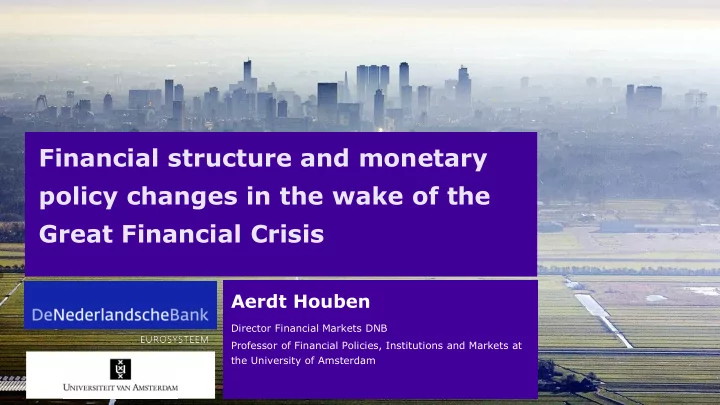

Financial structure and monetary policy changes in the wake of the Great Financial Crisis Aerdt Houben Director Financial Markets DNB Professor of Financial Policies, Institutions and Markets at the University of Amsterdam
More than 30 years … 1985 Charles Goodhart appointed Professor Banking and Finance 2019 Mary Pieterse-Bloem appointed Endowed Professor Financial Markets 2
Key take-aways Financial structure matters for the economy Financial structure not that relevant for conventional monetary policy Financial structure very relevant for unconventional monetary policy Europe requires a more balanced and integrated financial structure 3
Financial structure and the economy 4
Bank-dominant economies Higher severity of negative bank supply shocks Less room for markets as an alternative source of financing Higher output costs in financial crises Higher systemic risks 5
Implications: GDP growth Source: Gambacorta, Yang and Tsatsarnos (2014) 6
Implications: Output costs Source: Gambacorta, Yang and Tsatsarnos (2014) 7
Implications: Systemic risks 0.05 0.04 Systemic risk Minimized 0.03 0.02 0.01 0 0 1 2 3 4 5 6 Bank over market debt and equity financing US EMU Source: Bats and Houben (2017) 8
Financial structure and conventional monetary policy 9
Conventional monetary policy Financial structure not that relevant Price stability as the main objective Interbank interest rates as the intermediate operational target Interest rates for non-financial sectors follow (monetary transmission) 10
Interbank overnight interest rate 15 13 11 9 7 5 3 1 -1 1970 1977 1984 1991 1998 2005 2012 German European: EONIA 11
Monetary transmission Interest rates 7 6 5 4 3 2 1 0 2007 2008 2009 2010 2011 Interbank overnight Bank loans NL sovereign 2-Yrs 12
Effective lower bound Interbank overnight interest rate 1.2 1 0.8 0.6 0.4 0.2 0 -0.2 -0.4 2009 2011 2013 2015 2017 2019 13
Unconventional times Negative interest rates Forward guidance on interest rates Long-term refinancing operations Large-scale asset purchases 14
Financial structure and unconventional monetary policy 15
Large-scale asset purchases Extract duration and credit risk Lower market term premia Increase demand for market debt Portfolio rebalancing effects to other debt and bank loans 16
Asset purchases: financial structure matters Portfolio rebalancing effects are smaller when Capital markets are less developed Banks hold less market debt Banks primarily extend bank loans Banking market competition is low 17
Bank dominance requires a different instrument Long-term refinancing operations Reduce bank funding uncertainty and costs, especially in liquidity crises Lower term premia and increase bank credit demand Stimulate bank lending 18
Asset purchases versus refinancing operations Direct effect Asset Market debt purchases Portfolio Real rebalancing economy effects Direct effect Refinancing Bank loans operations 19
Financial structure matters Refinancing operations Asset purchases Mostly affects market financing Mostly affects bank financing (loans) (bonds, equity) More effective in market-based More effective in bank-based economies economies and during liquidity crises 20
ECB versus FED 21
Bank dependence in Europe… Private credit to non-financial sector (% of GDP) Stock market capitalization (% of GDP) 100 180 160 80 140 120 60 100 80 40 60 40 20 20 0 0 EMU USA US EMU Bank credit Market credit US EMU 22
… and heterogenous European markets … 1.0 Financial integration indicators eurozone 0.8 0.6 0.4 0.2 Quantity-based indicator Price-based indicator 0.0 1999 2002 2005 2008 2011 2014 2017 23
… required continued ECB refinancing … 1800 2.5 Low market stress 1600 2.0 1400 1200 1.5 1000 800 1.0 600 400 0.5 200 0 0.0 2007 2010 2013 2016 Allotted amount in billions (lhs) Euro area Libor-OIS spread in % (rhs) 24
…in contrast to the FED 3000 4.0 3.5 2500 3.0 2000 2.5 1500 2.0 1.5 1000 1.0 500 0.5 0 0.0 2007 2010 2013 2016 Allotted amount in billions (lhs) US Libor-OIS spread in % (rhs) 25
Balance sheets 5000 5000 FED ECB 4000 4000 Balance (US dollars billinos) Balance (EUR billions) 3000 3000 2000 2000 1000 1000 0 0 2003 2006 2009 2012 2015 2018 2003 2006 2009 2012 2015 2018 Lending All other assets Lending All other assets 26
Continued refinancing has drawbacks Reliance on (public) central bank refinancing Discouragement of (private) market funding for banks Reduced incentives for bank discipline 27
The way forward 28
Balanced financial structures in Europe Reduce European bank dependence Integrate European capital markets Provide alternative financing through European markets 29
Benefits Facilitate central bank intervention in crisis times Limit incentives for long-term refinancing operations Facilitate economic recovery Cushion bank supply shocks and lower systemic risk Share financial risks privately 30
How to get there? Complete the Banking Union Consistent application of resolution rules European Deposit Insurance Scheme Strengthen the Capital Markets Union Convergence in tax treatment of finance Streamline IPO prospectus regimes and reporting requirements Harmonize covered bonds regulation Convergence of European insolvency law 31
Recommend
More recommend